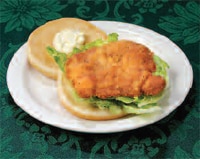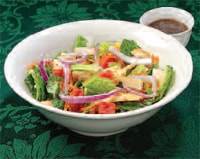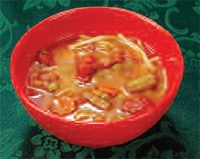Step 1 - Make fruits and veggies the largest portion of your meals.
This doesn't mean that paying attention to portion sizes is unnecessary. Portions still matter, however, because most fruits and vegetables are full of fiber and water, they generally provide more bulk. As a result, we tend to feel fuller and less likely to overeat portions of these foods than we would if we were eating a different type of food. For example, the American Institute for Cancer Research illustrates in the photo below the difference food choices can make when it comes to the amount of food served and calories. |
| Image from American Institute for Cancer Research |
The Centers for Disease Control (CDC) has another way of illustrating the impact that making fruits and veggies a bigger portion of your meal can have on calories.
 | |
| Fried Chicken Sandwich w/Tbsp. Mayo = 599 Calories |
 | |||
| Grilled Chicken Salad with low fat dressing - 2 cups lettuce, 2 oz. grilled chicken breast, 2 tbsp. light balsamic vinaigrette dressing = 178 calories |
Understanding Calories and Servings -
At this point you may be wondering how many calories you need daily and how many servings of fruits and veggies you should be eating. Let's take a look at calorie needs first because, "knowing your body's daily calorie needs can be an important first step in adopting a realistic diet and physical activity plan that can help you attain and maintain a healthy weight" (Baylor College of Medicine). In other words, when we have an idea of how many calories we need, we can make more informed decisions about the foods we choose to eat. You can determine an estimate of your calorie needs by using this American Council on Exercise's calorie calculator found here.Now let's take a look at how many servings of fruits and veggies are currently being recommended. There used to be a blanket recommendation that we all try to shoot for at least 5-7 servings a day. Now, according to the USDA, "the amount of fruits and vegetables you need to eat depends on your age, sex, and level of physical activity." You can find out your individual recommended total daily amounts for vegetables here and the daily amounts for fruits here. at the USDA's Choose My Plate site. Simply put, the current recommendation as of June, 2013, is to fill half of your plate with fruits and veggies.
The Chose My Plate site contains some really helpful information. By sharing all this I hope I haven't given you the wrong impression. Adopting a low energy, high nutrient density style of eating isn't a burdensome chore of calorie counting and food weighing. Initially, there is a period of adjustment as well as a learning curve, but in no time at all healthier nutrition habits will be formed.
Step 2 - Supplement meals with starchy fruits, vegetables, whole grains, legumes (beans), lean meats, fish and low-fat dairy foods (unless you're looking to go vegan, or vegetarian obviously) to create a healthy balanced diet.
For example, divide a dinner plate into 3 sections: the largest section would be the area containing vegetables, the remaining 2 sections of the plate could be supplemented with a whole grain and a lean meat. The Cleveland Clinic recommends the following:- "Filling 1/2 of your plate with non-starchy vegetables like broccoli, carrots and green beans
- Filling 1/4 of your plate with protein foods (3-4 ounces of fish, poultry or lean meat)
- Filling 1/4 of your plate with starchy carbohydrate foods such as potatoes, bread, rice, pasta or starchy vegetables
- Adding a small piece of fruit or 8 ounces of skim or low-fat milk, which are additional carbohydrate choices
- Using 1-2 teaspoons of heart-healthy vegetable oil
 |
| Image from Cleveland Clinic |
Step 3 - Watch your fat intake-
Watch your fat intake, especially saturated fats, and avoid trans fats altogether. Keep in mind, when broken down in the body a gram of fat will provide about 9 kcalories of energy. Compare this with a gram of carbohydrate at 4 kcalories and a gram of protein which also yields 4 kcalories, and it becomes apparent why fatty foods are more energy dense. Also, the type of fat we eat is important. The current wisdom is that when it comes to fat, the unsaturated fats found in foods like olives and nuts are the way to go, but the CDC recommends we consume these occasionally and in small portions. More information on this is available in the post on fats here and on the omega fats here. Bottom line - fat intake should not exceed 35% of calories and most fats should come from foods that contain unsaturated fat (CDC).Step 4 - Rarely eat, or be especially careful about portion size of foods with little moisture.
Remember that less energy dense foods typically contain more water. So foods that contain less water (like crackers, cookies and chips) provide a greater amount "of calories relative to their weight and can easily be over-consumed (CDC)."A few practical strategies to reduce energy density -
- Reduce fat and/or add water. The CDC has another helpful illustration of this strategy. They replace a cream based soup which contains more fat, with a water and vegetable based broth soup. The result is a more nutrient rich, less energy dense meal.
 | |
| Cream-based soup 1 cup mushroom bisque = 400 calories |
 |
| Broth-based soup 1 cup minestrone = 112 calories |
- Add extra vegetables to dishes and use lower fat meats and cheeses, or simply substitute lower energy density foods for those that are more energy dense. For example, instead of 1 cup of ice cream, have 1/2 cup of low-fat ice cream or sorbet, topped with 1/2 cup of fresh strawberries or blueberries (CDC).
- Watch your beverages. Liquid calories are sneaky and can add up. Just consider that a Starbucks grande iced caramel macchiato with 2% milk has 230 calories (Starbucks).
- Drink water or try eating a low energy density appetizer at the start of a meal. The CDC suggests a 100 kcal serving of a broth based soup or a green salad and recent studies have shown that drinking a glass or 2 of water before a meal helps also (National Library of Medicine).
- Preparation matters. The way foods are prepared is just as important as the foods we choose to eat. A potato that is baked rather than fried is a good example. Whenever possible fresh fruits, and vegetables are the way to go. Limit juices because these don't contain the fiber that can help with feeling full. Also, avoid fruit and vegetable dips that can add additional calories. Canned fruits without added sugar or corn syrup are ok. Canned vegetables without added salt, or frozen fruit and vegetables without added sauces are also good substitutes.
- Tip the balance to veggies. Vegetables tend to be lower in calories than fruit so try to tip the balance between the two in favor of the veggies.
Step 5 - Watch out for empty calories-
| Image from Livestrong |
The USDA has a good explanation of empty calories on their site found here. Briefly, empty calories are usually found in foods that contain solid fats and added sugar. The ratio of nutrient dense/energy dense calories is heavy on the energy. In other words, these foods are usually higher in calories, but contain less nutrients in comparison to their caloric content. For example, fried chicken - 3 medium fried chicken wings with skin and batter contain an estimated 478 calories of which an estimated 382 calories are empty! Compare this with a 3 oz. roasted chicken breast (skinless) that contains an estimated 138 calories ZERO of which are empty calories. The Choose My Plate site has a chart here that lists a variety of foods along with their empty calorie values.
Note: Anyone with a specific health condition should consult with a health care provider for a dietary plan that is right for them.
Sources
American Institute for Cancer Research - http://www.aicr.org/site/News2?page=NewsArticle&id=19233&news_iv_ctrl=2302
CDC - http://www.cdc.gov/healthyweight/healthy_eating/energy_density.html
USDA MyPyramid -http://www.mypyramid.gov/mypyramid/index.aspx
University of South Florida Health and Diabetes Center - http://www.health.usf.edu/NR/rdonlyres/41BE75B0-87FD-4536-B563-2C98E1D11C22/0/idaho_plate_method.gif
Cleveland Clinic - http://my.clevelandclinic.org/disorders/diabetes_mellitus/hic_nutrition_basics_for_cchs_diabetes_guide.aspx
Starbucks nutrition data -http://www.starbucks.com/menu/drinks/espresso/iced-caramel-macchiato#size=155347&milk=63
National Library of Medicine - http://www.nlm.nih.gov/medlineplus/videos/news/drink_up_090310.html

No comments:
Post a Comment